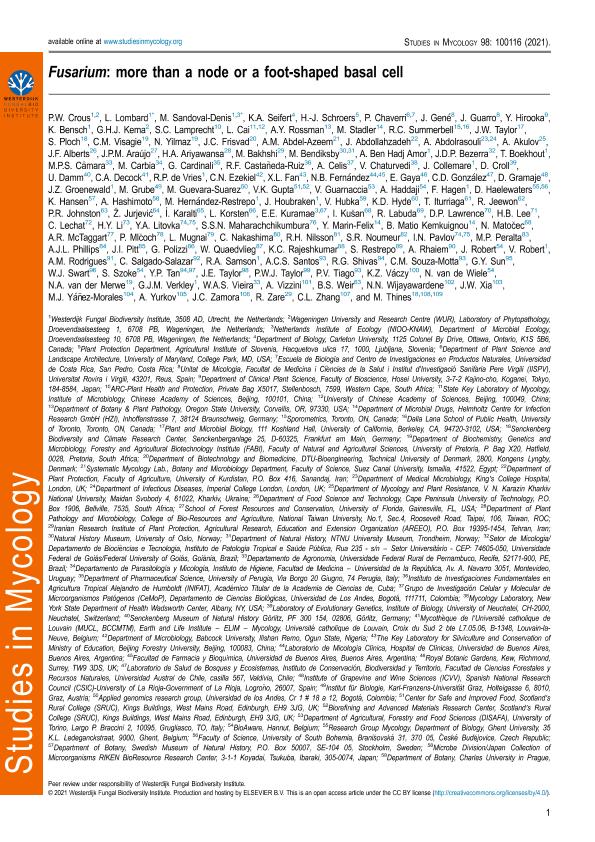Mostrar el registro sencillo del ítem
dc.contributor.author
Crous, Pieter Willem

dc.contributor.author
Lombard, L.
dc.contributor.author
Sandoval Denis, M.
dc.contributor.author
Seifert, K. A.
dc.contributor.author
Schroers, H. J.
dc.contributor.author
Chaverri, P.
dc.contributor.author
Gené, J.
dc.contributor.author
Guarro, J.
dc.contributor.author
Hirooka, Y.
dc.contributor.author
Bensch,K.
dc.contributor.author
Kema,G. H. J.
dc.contributor.author
Lamprecht, S. C.
dc.contributor.author
Cai, L.
dc.contributor.author
Rossman, A. Y.
dc.contributor.author
Peralta, Maria Patricia

dc.date.available
2022-05-30T12:29:33Z
dc.date.issued
2021-03
dc.identifier.citation
Crous, Pieter Willem; Lombard, L.; Sandoval Denis, M.; Seifert, K. A.; Schroers, H. J.; et al.; Fusarium: more than a node or a foot-shaped basal cell; Centraalbureau Schimmelculture; Studies In Mycology; 98; 3-2021
dc.identifier.issn
1872-9797
dc.identifier.uri
http://hdl.handle.net/11336/158458
dc.description.abstract
Recent publications have argued that there are potentially serious consequences for researchers in recognising distinct genera in the terminal fusarioid clade
of the family Nectriaceae. Thus, an alternate hypothesis, namely a very broad concept of the genus Fusarium was proposed. In doing so, however, a significant body of
data that supports distinct genera in Nectriaceae based on morphology, biology, and phylogeny is disregarded. A DNA phylogeny based on 19 orthologous protein-coding
genes was presented to support a very broad concept of Fusarium at the F1 node in Nectriaceae. Here, we demonstrate that re-analyses of this dataset show that all 19
genes support the F3 node that represents Fusarium sensu stricto as defined by F. sambucinum (sexual morph synonym Gibberella pulicaris). The backbone of the
phylogeny is resolved by the concatenated alignment, but only six of the 19 genes fully support the F1 node, representing the broad circumscription of Fusarium.
Furthermore, a re-analysis of the concatenated dataset revealed alternate topologies in different phylogenetic algorithms, highlighting the deep divergence and unre-
solved placement of various Nectriaceae lineages proposed as members of Fusarium. Species of Fusarium s. str. are characterised by Gibberella sexual morphs,
asexual morphs with thin- or thick-walled macroconidia that have variously shaped apical and basal cells, and trichothecene mycotoxin production, which separates them
from other fusarioid genera. Here we show that the Wollenweber concept of Fusarium presently accounts for 20 segregate genera with clear-cut synapomorphic traits,
and that fusarioid macroconidia represent a character that has been gained or lost multiple times throughout Nectriaceae. Thus, the very broad circumscription of
Fusarium is blurry and without apparent synapomorphies, and does not include all genera with fusarium-like macroconidia, which are spread throughout Nectriaceae
(e.g., Cosmosporella, Macroconia, Microcera). In this study four new genera are introduced, along with 18 new species and 16 new combinations. These names convey
information about relationships, morphology, and ecological preference that would otherwise be lost in a broader definition of Fusarium. To assist users to correctly
identify fusarioid genera and species, we introduce a new online identification database, Fusarioid-ID, accessible at www.fusarium.org. The database comprises partial
sequences from multiple genes commonly used to identify fusarioid taxa (act1, CaM, his3, rpb1, rpb2, tef1, tub2, ITS, and LSU). In this paper, we also present a
nomenclator of names that have been introduced in Fusarium up to January 2021 as well as their current status, types, and diagnostic DNA barcode data. In this study,
researchers from 46 countries, representing taxonomists, plant pathologists, medical mycologists, quarantine officials, regulatory agencies, and students, strongly support
the application and use of a more precisely delimited Fusarium (= Gibberella) concept to accommodate taxa from the robust monophyletic node F3 on the basis of a well-
defined and unique combination of morphological and biochemical features. This F3 node includes, among others, species of the F. fujikuroi, F. incarnatum-equiseti, F.
oxysporum, and F. sambucinum species complexes, but not species of Bisifusarium [F. dimerum species complex (SC)], Cyanonectria (F. buxicola SC), Geejayessia
(F. staphyleae SC), Neocosmospora (F. solani SC) or Rectifusarium (F. ventricosum SC). The present study represents the first step to generating a new online
monograph of Fusarium and allied fusarioid genera
dc.format
application/pdf
dc.language.iso
eng
dc.publisher
Centraalbureau Schimmelculture

dc.rights
info:eu-repo/semantics/openAccess
dc.rights.uri
https://creativecommons.org/licenses/by-nc-sa/2.5/ar/
dc.subject
MULTI-GENE PHYLOGENY
dc.subject
MYCOTOXINS
dc.subject
NECTRIACEAE NEOCOSMOSPORA
dc.subject
NOVEL TAXA PATHOGEN TAXONOMY
dc.subject.classification
Micología

dc.subject.classification
Ciencias Biológicas

dc.subject.classification
CIENCIAS NATURALES Y EXACTAS

dc.title
Fusarium: more than a node or a foot-shaped basal cell
dc.type
info:eu-repo/semantics/article
dc.type
info:ar-repo/semantics/artículo
dc.type
info:eu-repo/semantics/publishedVersion
dc.date.updated
2022-05-23T22:25:21Z
dc.journal.volume
98
dc.journal.pais
Países Bajos

dc.description.fil
Fil: Crous, Pieter Willem. Westerdijk Fungal Biodiversity Institute; ; Países Bajos
dc.description.fil
Fil: Lombard, L.. Westerdijk Fungal Biodiversity Institute; ; Países Bajos
dc.description.fil
Fil: Sandoval Denis, M.. Westerdijk Fungal Biodiversity Institute; ; Países Bajos
dc.description.fil
Fil: Seifert, K. A.. Department Of Biology, Carleton University; ; Estados Unidos
dc.description.fil
Fil: Schroers, H. J.. Plant Protection Department; ; Estados Unidos
dc.description.fil
Fil: Chaverri, P.. Department Of Plant Science And Landscape Architecture; ; Estados Unidos
dc.description.fil
Fil: Gené, J.. Unitat de Micologia, Facultat de Medicina I Ciències;; Francia
dc.description.fil
Fil: Guarro, J.. Unitat de Micologia, Facultat de Medicina I Ciències; ; Francia
dc.description.fil
Fil: Hirooka, Y.. Department Of Clinical Plant Science; ; Estados Unidos
dc.description.fil
Fil: Bensch,K.. Westerdijk Fungal Biodiversity Institute; ; Países Bajos
dc.description.fil
Fil: Kema,G. H. J.. Westerdijk Fungal Biodiversity Institute; ; Países Bajos
dc.description.fil
Fil: Lamprecht, S. C.. Plant Health And Protection; ; Estados Unidos
dc.description.fil
Fil: Cai, L.. State Key Laboratory Of Mycology; ; Estados Unidos
dc.description.fil
Fil: Rossman, A. Y.. Department Of Botany & Plant Pathology; ; Estados Unidos
dc.description.fil
Fil: Peralta, Maria Patricia. Consejo Nacional de Investigaciones Científicas y Técnicas. Centro Científico Tecnológico Conicet - Tucumán. Planta Piloto de Procesos Industriales Microbiológicos; Argentina
dc.journal.title
Studies In Mycology

dc.relation.alternativeid
info:eu-repo/semantics/altIdentifier/doi/https://doi.org/10.1016/j.simyco.2021.100116
Archivos asociados
